Cat × Duck
Mammalian Hybrids
EUGENE M. MCCARTHY, PHD GENETICS, ΦΒΚ
|
I felt like one of those ducklings inexplicably bonded to a mother cat.
—Sue Grafton‡
|
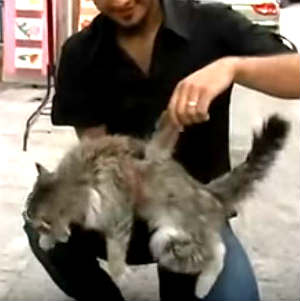 Above: Screenshot from the video immediately below.
Above: Screenshot from the video immediately below.Three live cats with wings.
Another cat with wings.
Claims that hybrids can be produced from this highly disparate cross require confirmation from a testable specimen.
People who wish to explain away these animals claim their winglike appendages are composed of mere matted hair or that they are the result of a rare skin condition, known as “cutaneous asthenia.” But the second cat in the upper video at right can be seen moving its wings. So it seems these appendages, at least in some cases, have muscles. And many of the reports state, too, that these growths contain bones and that they can be extended, which would not be possible if they were simple flaps of skin or matted hair.
When I first encountered reports relating to this cross, it seemed to me that even a friendly association between a duck and a cat would be something extremely unusual. And that, indeed, was the opinion of the people in the video (“Cat adopts three ducklings”) below before their cat adopted three ducklings, nursed them, and raised them to maturity. Ducks also sometimes adopt kittens, though they are, of course, unable to nurse them (see video below, “Duck adopts kittens”).
I only bring up the fact that ducks are known sometimes to raise kittens, and vice versa, because it is also well known that animals, when they reach sexual maturity, typically choose to mate with whatever type of animal raised them, a phenomenon known as “imprinting,” and cats have in fact been observed mating with various birds, particularly chickens (see video below, “Cats sometimes mate with birds”).
Duck adopts kittens:
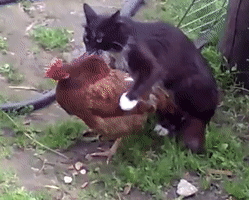
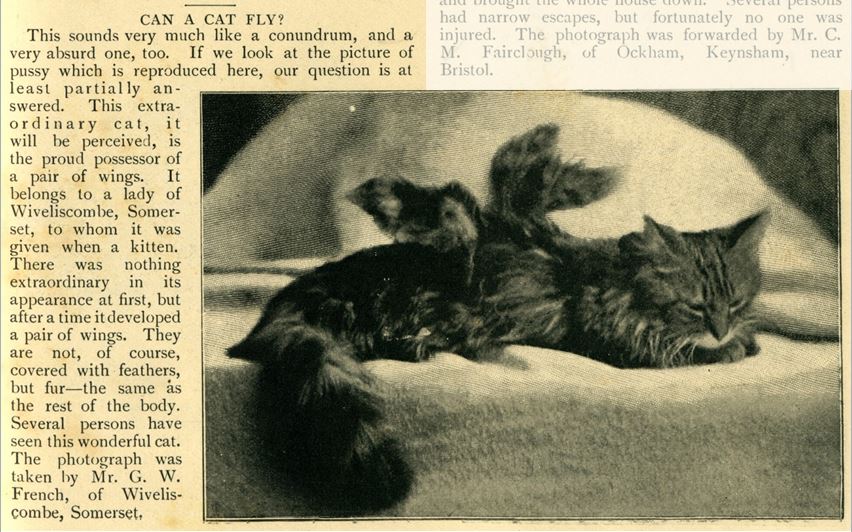 The Wiveliscombe winged cat, from the November 1899 issue of Strand Magazine.
The Wiveliscombe winged cat, from the November 1899 issue of Strand Magazine.
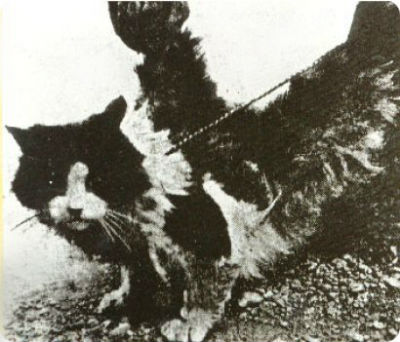 The Oxford winged cat (see reports below and at right). The Oxford winged cat (see reports below and at right).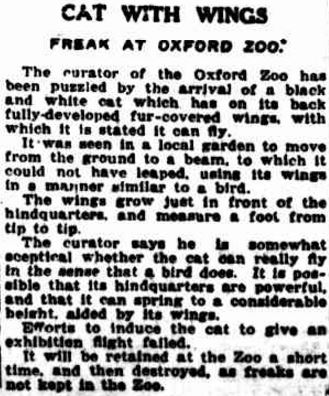
|
The Oxford Winged Cat
In the 1930s a winged cat was discovered roaming wild in Oxford, England. It was put on display at the Oxford Zoo. The Daily Mirror sent a reporter to the scene. The following is a transcript of his 9 June, 1933 story: “A few days ago neighbours of Mrs Hughes Griffiths of Summerstown, Oxford saw a strange black and white cat prowling round her garden. Last evening Mrs Hughes Griffiths saw the cat in a room of her stables. She says “I saw it move from the ground to a beam — a considerable distance which I don’t think it could have jumped — using its wings in a manner similar to that of a bird.” Mrs Hughes Griffiths at once telephoned Oxford Zoo, and Mr Owen the managing director and a Mr W. E. Sawyer, the curator, went to her house and captured the animal in a net. I have myself carefully examined the cat tonight, and there is no doubt about the wings, they grow just in front of its hindquarters.” (See picture and additional news report at left.) |
A clutch of duck-cat hybrids in Normandy
An old report, published in the May 14th, 1778 issue of the French medical journal Gazette de Santé (pp. 79-80), tells of a clutch of three hybrids laid by a duck in Normandy.
Note that in the report no mention is made of any actual mating between a cat and a duck (though mating has been observed between combinations of cat and various other birds, such as the cat and chicken shown in the video above).
Instead, the notion is expressed that the eggs were somehow altered by the cat’s “emanations,” (probably a reference to “animal magnetism,” a force that supposedly radiated out of animals and had physical effects).
At any rate, here is a translation of this old and odd report about what seem to be duck-cat hybrids hatching from duck eggs (a transcript of the French original appears at the bottom of this page):
We are not in the habit of reporting monstrosities, since they ordinarily add nothing to the sum of our knowledge. However, there are certain individuals of this kind that serve to throw light on the most secret mysteries of nature, such as the generation of animals. Moreover, in publishing the following facts, we are attempting to accommodate the curiosity of certain individuals who desired us to do so.
A person whose testimony cannot be doubted (Monsieur Vimont, a doctor of medicine) informs us from the town of Le Sap in Normandy, where he lives, that in a certain house there where duck eggs are regularly incubated under hens, twelve such eggs were placed under a hen who was on friendly terms with a cat, and the cat, wanting to share his friend’s labor, took three of the twelve to lie upon himself. At the end of the usual term of incubation the nine eggs tended by the hen hatched nine ordinary ducklings. But the three of the cat still had not hatched. For 4 or 5 days, the cat remained upon his clutch, and then, when at last the eggs were opened, everyone was astonished to find in each a little monster partaking of the nature both of a cat and a duck. Two were living, the other dead. Dr. Vimont, who reports this event, has preserved one of these little duck-cat monsters in spirits, and offers to send it to anyone who might be curious about such phenomena. Here is a description:
The lower jaw is similar to an ordinary bird beak, that is to say, a duck’s, the tongue stretching its entire length. But, instead of an upper beak, there is the nose or muzzle of a cat. [This configuration is reminiscent of certain reported chicken-duck hybrids that allegedly had the upper mandible of a chicken and the lower mandible of a duck, and for bird-headed trout reported by Carlet.] These little monsters have four legs, and the feet are webbed like those of a duck, but the nails end in very sharp claws. They also have wings, which arise from the shoulder joint. The whole body is covered with a long dark-brown down.
Certainly, this is all food for thought, and the most peculiar aspect of the case is the effect of the cat’s emanations, which were able to alter the form generated by the primitive germ, or at least to add to it. All this goes to show that the mechanism, by which an animal breeds and takes on a particular form, remains an impenetrable mystery. [Translated by E. M. McCarthy. Original French appears below]
Vimont did in fact send one of his duck-cat creatures to the editors of the Gazette de Santé so that they could carry out an examination, the results of which appear in the June 11, 1778 issue (p. 98) of the Gazette:
1716-1800
We found that the head of the little monster was open at the rear [probably anencephaly and/or spina bifida, which commonly occurs in distant hybrids], but that the forepart was intact (with the exception of the eyes). The posterior portion of the head differs from that of an ordinary duck in that the upper portion of the bill is rounded in the form of a nose or muzzle, as in ordinary quadrupeds. It is, however, sheathed in the same horny substance [i.e., keratin and other proteins] as that which covers the bill of a duck. Two distinct nostrils placed at the extremity can be seen with a magnifying glass. The four feet were perfectly similar to those of a duckling [see the old report by Paullini below which claims a cat with the perfect feet of a goose had been preserved in a neighboring monastery], as were the nascent wings. We found no difference between the fluff, which covered them both, except in the feather barbs, which were much more easily visible in the ordinary duckling than in those of the little monster. Such, then was the result of our examination. [Translated by E. M. McCarthy. Original French.]
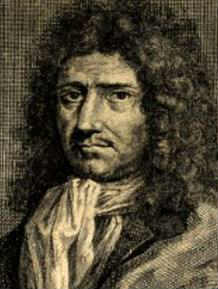 Paullini
PaulliniChristian Franz Paullini (1686) communicated an abridgement of a manuscript compilation of curiosities collected by the monks Isibordus von Amelunxen and Alexander Insulanus at the Imperial Abbey of Corvey around 1200 A.D. Observation LIII Paullini 1686, p. 212 of that compilation states that in the year 1194, “near the abbey, a cat had been born with the perfect feet of a goose, which Abbot Isibordus had preserved on account ot its rarity.” (See also: Isensee 1843, p. 287)
So, at least according to the report, these strange hatchlings of a duck had four legs, and wings sprouting from their shoulders, as do the reported adult winged cats. There is also a similar and more recent reported instance of a winged cat hatching from a chicken egg. These reports suggest that the best explanation of winged cats is not that they are mutants, nor that they have a skin disease or matted hair, but rather that they are bird-mammal hybrids, apparently hatched from eggs laid by birds. The only difficulty with this conclusion is that it requires one to accept that such distant hybrids can occasionally occur.
In addition to the one just quoted, this website lists at least two other crosses in which ostensible bird-mammal hybrids are described as having noses shaped like a mammal’s but covered with horn (i.e., a hard sheath composed of keratin and other proteins) like the beak of a bird. One is dog x parrot, the other is human x chicken.
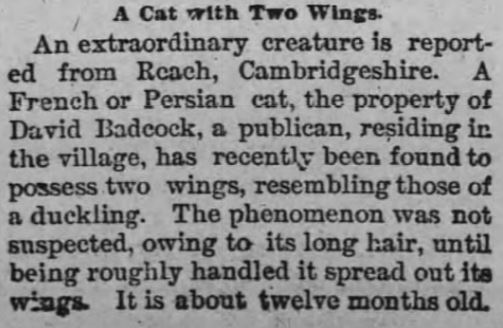 A widely circulated news report about a cat in the town of Reach, Cambridgeshire, UK, with wings like a duckling (St. Joseph's, Missouri, Saturday Herald, Mar. 9, 1895, p. 6, col. 6)
A widely circulated news report about a cat in the town of Reach, Cambridgeshire, UK, with wings like a duckling (St. Joseph's, Missouri, Saturday Herald, Mar. 9, 1895, p. 6, col. 6)In Walden, Henry David Thoreau gave the following account: “A few years before I lived in the woods there was what was called a ‘winged cat’ in one of the farm-houses in Lincoln nearest the pond, Mr. Gilian Baker’s. When I called to see her in June 1842 she was gone a-hunting in the woods, as was her wont (I am not sure whether it was a male or a female and so use the more common pronoun), but her mistress told me that she came into the neighbourhood a little more than a year before, in April, and was finally taken into their house; that she was of a dark brownish-grey colour, with a white spot on her throat, and white feet, and had a large bushy tail like a fox; that in the winter the fur grew thick and flatted out along her sides, forming strips ten or twelve inches long by two and a half wide, and under her chin like a muff, the upper side loose, the under matted like felt, and in the spring these appendages dropped off. They gave me a pair of her ‘wings,’ which I keep still. There is no appearance of a membrane about them. Some thought it was part flying squirrel or some other wild animal, which is not impossible, for, according to naturalists, prolific hybrids have been produced by the union of the marten and domestic cat. This would have been the right kind of cat for me to keep if I had kept any; for why should not a poet’s cat be winged as well as his horse?”
‡ Source of epigraph: “F” is for Fugitive by Sue Grafton, 1989, p. 14).
A list of cat crosses
The following is a list of reported cat crosses. Some of these crosses are much better documented than others (as indicated by the reliability arrow). Indeed, some might seem completely impossible. But all have been reported at least once. The links below are to separate articles. Additional crosses, not listed here, are covered on the cat hybrids page.
|
|
By the same author: Handbook of Avian Hybrids of the World, Oxford University Press (2006).
Original French of text translated above: “Quoique nous ne soyons pas dans l’usage d’annoncer les monstruosités, qui pour l’ordinaire n’augmentent en rien la sòmme de nos connoissances; il en est cependant d’un genre qui peuvent donner lieu à de nouvelles recherches & servir à jetter quelque jour sur les mysteres les plus cachés de la nature, tel celui de la génération des animaux. Nous avons cède d’ailleurs aux instances de quelques curieux qui nous ont prié de publier le fait suivant.
“Une personne dont le témoignage ne sauroit être suspect (M. Vimont Doct. en Médecine) nous mande du bourg Sap en Normandie, où il demeure, que dans une maison de cet endroit où l’on étoit dans l’usage de faire couver les oeufs de canne par des poules, douze de ces ayant été mis, dans cette intention, sous une poule, un chat avoit contracté une amitié singuliere avec cet animal, avoit voulu partager fa peine; j qu’il en avoit tiré trois à lui fut lesquels il s’étoit couché à l’exemple de la poule; qu’au bout du terme ordinaire de incubation les neuf œufs couvés par la poule avoient donné neuf cannetons, mais que les trois que le chat avoit fomentés de sa chaleur n’avoient d’abord rien produit; qu’au bout de 4 ou 5 jours, le chat ne les quittant pas, on avoit pris le parti de les casser, & qu’on a été très surpris de trouver dans chacun de ces œufs un petit monstre participant de la nature du chat & de celle du canard, dont deux étoient vivans & l’autre mort. M. Vimont, auteur de cette observation, conserve un de ces monstres canard-chat dans l’eau-de-vie. & qu’il offre d’envoyer aux curieux de ces sortes de phénomènes. En voici la description.
“La mâchoire inférieure est semblable à celle qui sert à former le bec des oiseaux, c’est-à-dire, du canard, avec une langue qui occupe toute la longueur de cette partie. A la place de la partie supérieure du bec on voit un nez ou museau de chat. Ce petit monstre a quatre pates, dont les pieds font membraneux comme ceux du canard, avec cette différence que les ongles finissent en petites griffes très-pointues & très-fines. Cet animal a des aîles qui prennent naissance à l’articulation des épaules. Tout le corps est recouvert d’un long duvet noir-brun qu’on prendroit pour du poil. Voilà une belle matière à réflexions. Ce qu’il y a de plus singulier dans cette observation, c’est l’effet des émanations du chat sur ces oeufs, lesquelles été capables de changer la forme primitive du germe, ou du moins d’y ajouter; ce qui prouve de plus en plus que le méchanisme par lequel l’animal se reproduit & prend une forme décidée, est encore un mystère impénétrable.”
Most shared on Macroevolution.net:
Human Origins: Are we hybrids?
On the Origins of New Forms of Life
Mammalian Hybrids
Cat-rabbit Hybrids: Fact or fiction?
Famous Biologists
Dog-cow Hybrids
Georges Cuvier: A Biography
Prothero: A Rebuttal
Branches of Biology
Dog-fox Hybrids